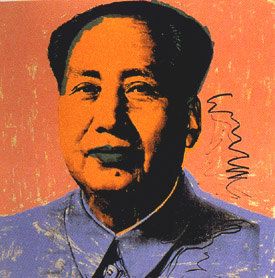I like this better than our culture. It’s simpler. I love all the blue clothes. Everyone wearing blue.
Warhol's Mao series was inspired by Bruno Bischofberger, Warhol’s dealer who wanted Warhol to go back to making portraits and suggested he creates portraits of the most important figures in the 20th century. At the time, in 1972, Nixon had just made his historic visit to China and Mao had been declared the most famous person in the world by Life magazine.
Andy Warhol based his 10 screenprints that comprise the present work on Mao's official portrait, the very one that was on the cover of the (in)famous Little Red Book.
Maoism's mass ideology and Mao's cult-time following could only attract Warhol. The series manages to show Warhol’s fascination with the clash of imagery between Communist propaganda and Western fashion kitsch. "The creation of a glammed up iconic image of Mao outwardly translates this powerful, mysterious and somewhat intimidating image of Communist propaganda into a glamorized 1970s ready-made pop icon, embodying absolute political and cultural power, reminiscent of Warhol’s celebrity portraiture."
When he finally made it to China in 1982, after Mao's death and Deng Xiaoping's "Open Door" economic policy, Warhol’s love of repetition and mass production rendered China somewhat of a wonderland for the artist.
“It was a Warholian experience. Here’s the guy that did the Campbell’s soup can – he was all about the multiplicity of things – and here was a whole lifestyle based on that idea.” Warhol concurred, reflecting at the time, “I like this better than our culture. It’s simpler. I love all the blue clothes. Everyone wearing blue. I like to wear the same thing every day.”
The whole series is now available in our boutique Photo Image Gallery - rue Haute 92 - 1000 Brussels











